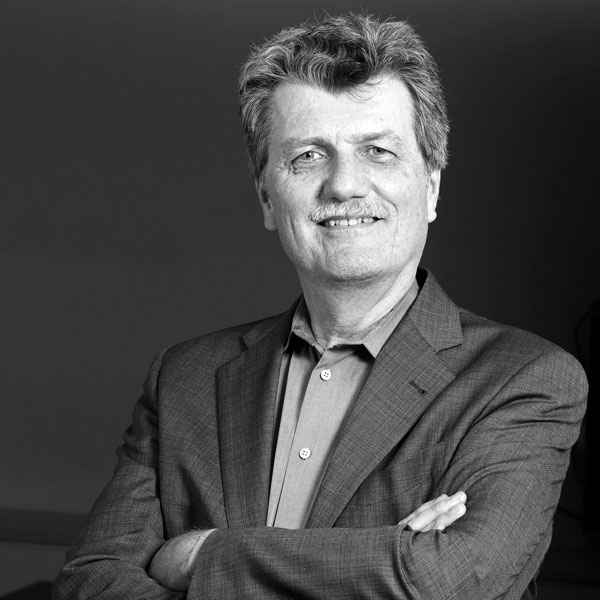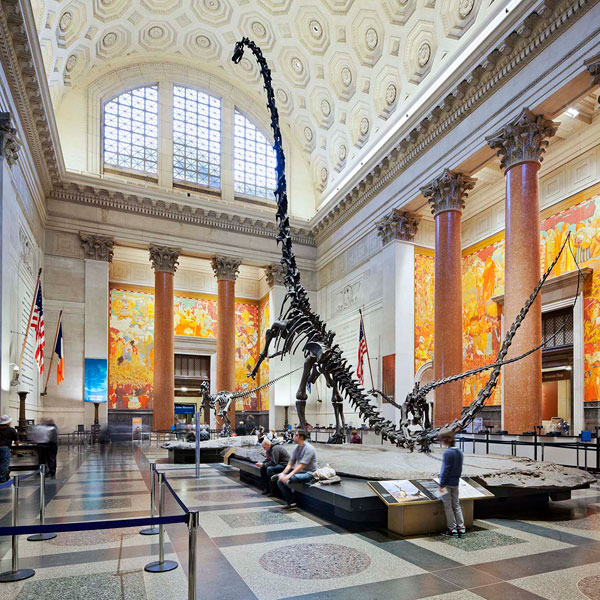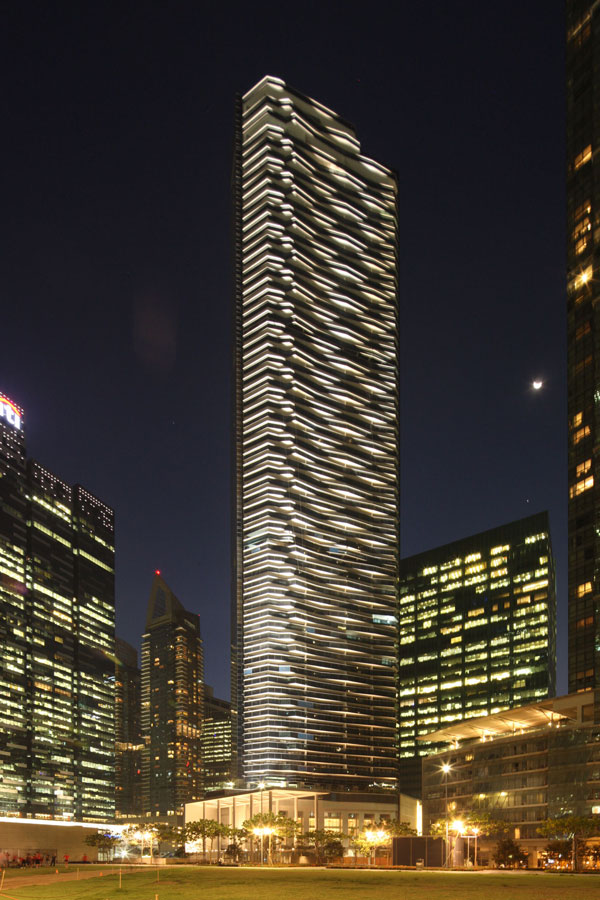As a key player in the field of architectural lighting design, Brandston Partnership Inc. has been responsible for illuminating many iconic buildings and spaces around the world. As the firm marks its 50th anniversary and the opening of a Singapore office, we chat with Robert Prouse, partner at the firm.

June 22nd, 2016
Top image: Marina Bay Financial Centre, Singapore
Images courtesy of Brandston Partnership Inc.
Brandston Partnership Inc. is recognised as a pioneer in the field of architectural lighting design. When the firm, founded by Howard Brandston, opened its doors in New York City in 1966 the profession as we know it today didn’t exist. The field of lighting design has come a long way since, and Brandston Partnership Inc. (BPI) is not only going strong, but counts iconic landmarks such as the Statue of Liberty, New York’s Battery Park City, Kuala Lumpur’s Petronas Twin Towers, and Singapore’s Marina Bay Financial Centre as part of its 4,000-strong international body of work.
BPI’s principals were recently in town to launch the firm’s Singapore office and celebrate the company’s 50th year in the business. We took the opportunity to chat with Robert Prouse, partner at BPI.

Robert Prouse, partner at Brandston Partner Inc.
BPI has been in the business of lighting design for half a century. How has the profession evolved since you began your work?
When Howard started the firm 50 years ago, the concept of paying somebody a fee to just design the lighting as opposed to supply it was kind of a novel concept. Howard and a few others of those early pioneers not only made a business for themselves, but they really created the profession. By the time I came along a few years later it had improved – the concept of hiring an independent lighting designer with no ties to a manufacturer was established, but not widely. There were a few architects who understood the concept and urged others to hire us. Howard also made contact directly with developers in New York so he had ties to them and they understood the value of his services. And that’s how it all got started.
In the beginning when we had to hire someone we typically had to find individuals who were trained either as an interior designer or as an architect, or even as a theatre designer because there were no educational programmes in architectural lighting. Then gradually programmes started to develop, like Parsons and all the others that exist around the world today.
How does BPI approach each project? What are the overarching considerations?
As Howard always used to say: “What do you want to see?” Once you have answered that question fully then the business of figuring out what the lighting should do to reveal the space in that way is much easier. If you start throwing light around it doesn’t really work.
That then evolves into considerations of what the space is and what the opportunities are. If there is a glass wall you’re not going to light the glass wall. If there is a nice big white wall you would probably light that; you would compose a palette of possibilities…

American Museum of Natural History, New York
Technology obviously has an important part to play in lighting and lighting design. LED presents the very latest in lighting technology – it is commonplace now and has lots of advantages, but what of the disadvantages, such as the higher cost?
Like any technology the cost has been coming down. It’s still more expensive to light a building with LEDs than with other possibilities, but it’s almost unavoidable [not to use it]. The downside really is that the technology and the business is evolving so fast that there is really only a handful of companies that we trust to provide LEDs that we know will function as they are advertised to function, and that will last as long as they say they will.
What does the future hold for lighting technology? Beyond LEDs, is there something else we have to look forward to?
It’s hard to say. There are organic LEDs coming along and they are popping up here and there, but it’s not like the next generation, rather, a refinement of what we have now.
They are still in a kind of R&D phase. In theory, they will perform more reliably, they will be more consistent across the performance spectrum, they will last longer, they will be more efficient. But who knows? That’s the theory anyway.
What are the main challenges facing lighting designers today?
The codes that we have to work with all over the world are becoming increasingly stringent, driving us to use lower and lower wattages, and the codes are not, in my opinion, entirely well thought out. They don’t seem to recognise certain facts that you get involved in when you get into a project.
The other challenge I think is that we have kind of all understood how to go about lighting spaces with incandescent and fluorescent sources and the smaller metal halide sources. Now we have to figure out how to do them with the LED sources. And that presents some technical issues – fixture sizes and performance issues.

Marina Bay Financial Centre, Singapore
Why have you decided to set up an office in Singapore?
Well there’s a lot of work here. We’ve done work in Singapore going back to the Ritz-Carlton project in the ‘90s, so we’ve been doing work in Singapore for a while. Our most recent projects are the Marina Bay Financial Centre and Asia Square.
Other firms that have a base here can much more easily service a project, especially during construction when you have to kind of show up on a regular basis. Which is why we thought a long time ago that we really needed to set up an office in Singapore, and finally we have.
Let’s talk about some of BPI’s most pivotal projects and why they are significant. I know you’ve done 4,000 over projects, so it’s a tough question!
Well the most iconic one would be the refurbishment of the Statue of Liberty [1986]. The most interesting part of that project was about the torch. The whole statue is hammered copper and the torch was originally built that way as well. Then somewhere along the line the torch was changed to an internally illuminated glass torch, but it was problematic because it leaked and maintenance was a problem, so they wanted to change it back to the original hammered copper material. It was Howard’s idea to cover it with gold leaf. Of course that took some convincing, but we did a mock up and they were convinced, and to this day it’s still quite beautiful.
Another project in the early to mid-‘80s is the Battery Park City in New York. It’s about 90 acres of landfill along the Hudson River. And it set a pattern for urban development that is still around to this day.
In your view, where does lighting design sit in the whole scheme of a project, in the whole scheme of building a space?
An architect once said to me that he’s designed many spaces, he’s designed many buildings, and he knows what the building is going to look like in the day time but he doesn’t know what it’s going to look like when the sun goes down and the electric lights come on, which is where we come in. Sometimes the goal is to make it look as much like it does in the day time as possible, but other times it’s just to make it feel like you want it to feel, [and to illuminate] what you wish to see.
Brandston Partnership Inc.
brandston.com
A searchable and comprehensive guide for specifying leading products and their suppliers
Keep up to date with the latest and greatest from our industry BFF's!

Create a configuration to suit your needs with this curved collection.

Sub-Zero and Wolf’s prestigious Kitchen Design Contest (KDC) has celebrated the very best in kitchen innovation and aesthetics for three decades now. Recognising premier kitchen design professionals from around the globe, the KDC facilitates innovation, style and functionality that pushes boundaries.

The Sub-Zero Wolf showrooms in Sydney and Melbourne provide a creative experience unlike any other. Now showcasing all-new product ranges, the showrooms present a unique perspective on the future of kitchens, homes and lifestyles.

In the pursuit of an uplifting synergy between the inner world and the surrounding environment, internationally acclaimed Interior Architect and Designer Lorena Gaxiola transform the vibration of the auspicious number ‘8’ into mesmerising artistry alongside the Feltex design team, brought to you by GH Commercial.

Simone Farresin and Andrea Trimarchi, the Italian design duo who comprise Formafantasma, have been challenging notions of what design can be for over a decade.

Lighting can play a crucial role in working symbiotically with a heritage structure – bringing to light the existing beauty of an older building. As Martin Klaasen, founder and director of Klaasen Lighting Design (KLD) shares.
The internet never sleeps! Here's the stuff you might have missed

Dallas Rogers, Head of Urban Discipline at the School of Architecture, Design and Planning, University of Sydney, comments on the history of map-making in our cities.

2024’s theme, “Reawaken,” calls for a journey through reinvention and sustainability.